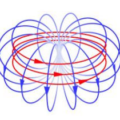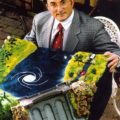
Seven years ago, two research groups turned the field of cosmology on its head with their announcements that the expansion of the universe was accelerating. Their theories were based on the red-shift of light from distant supernovae, and their findings suggested that the expansion of the universe was actually accelerating, not decelerating. The mysterious force behind this accelerated expansion was given the name “dark energy”. Prior to this, conventional scientific wisdom held that the Big Bang had resulted in an expansion of the universe that would gradually be slowed down and eventually reverse, ending in a Big Crunch.
Now, cosmologists are scrambling to determine what exactly dark energy is and understand how it affects the expansion of the universe. Back in 1917, Einstein amended his General Theory of Relativity with a cosmological constant, which, if the value was right, would allow the universe to exist in a perfectly balanced, static state. Einstein later called the addition of this constant his “greatest blunder,” but the notion of dark energy has revived the idea. “The cosmological constant was a vacuum energy [the energy of empty space] that kept gravity from pulling the universe in on itself,” said Eric Linder, of Berkeley Lab.
To answer the questions posed by dark energy, Linder and Robert Caldwell of Dartmouth, have proposed several scenarios for how dark energy might interact with the universe. Their paper, to be published in Physical Review Letters, identifies models of dark energy which could be used to rule out Einstein’s cosmological constant and explain the nature of dark energy. And, scientists should be able to determine which of these scenarios is correct with the experiments being planned for the Joint Dark Energy Mission (JDEM) that has been proposed by NASA. “Scientists have been arguing the question ‘how precisely do we need to measure dark energy in order to know what it is?'” said Linder.
JDEM could be part of the SuperNova/Acceleration Probe (SNAP), a three-mirror, 2-meter reflecting telescope in deep-space orbit that would be used to find and measure thousands of Type Ia supernovae each year. These measurements should provide enough information to clearly point towards either the thawing or freezing scenario – or to something else entirely new and unknown.
In their paper, Linder and Caldwell describe two scenarios, one they call “thawing” and one they call “freezing,” which point toward distinctly different fates for our permanently expanding universe. Under the thawing scenario, the acceleration of the expansion will gradually decrease and eventually come to a stop. Expansion may continue more slowly, or the universe may even collapse. Under the freezing scenario, acceleration continues indefinitely, like a car with the gas pedal pushed to the floor. Both of these scenarios rule out Einstein’s cosmological constant. Under any scenario, however, dark energy is a force that must be reckoned with. “Because dark energy makes up about 70 percent of the content of the universe, it dominates over the matter content. That means dark energy will govern expansion and, ultimately, determine the fate of the universe,” said Linder.
So where does dark energy come from? Enter the concept of “quintessence.” “Quintessence is a dynamic, time-evolving, and spatially dependent form of energy with negative pressure sufficient to drive the accelerating expansion,” said Caldwell. “Whereas the cosmological constant is a very specific form of energy – vacuum energy – quintessence encompasses a wide class of possibilities.”
Linder and Caldwell have proposed tests to see if quintessence – named after the fifth element of the ancient Greeks – is the source of dark energy. As the basis for those tests, Linder and Caldwell used a scalar field as their model. A scalar field possesses a measure of value, but not direction, for all points in space. With this approach, they were able to show quintessence as a scalar field relaxing its potential energy down to a minimum value. An analogy might be a set of springs under tension and exerting a negative pressure that counteracts the positive pressure of gravity. “A quintessence scalar field is like a field of springs covering every point in space, with each spring stretched to a different length,” Linder said. “For Einstein’s cosmological constant, each spring would be the same length and motionless.”
Under the thawing scenario, the potential energy of the quintessence field was “frozen” in place until the decreasing material density of an expanding universe gradually released it. In the freezing scenario, the quintessence field has been rolling towards its minimum potential since the universe underwent inflation, but as it comes to dominate the universe it gradually becomes a constant value. “If the results from measurements such as those that could be made with SNAP lie outside the thawing or freezing scenarios, then we may have to look beyond quintessence, perhaps to even more exotic physics, such as a modification of Einstein’s General Theory of Relativity to explain dark energy,” concluded Linder.
More reading: The limits of quintessence
by R.R. Caldwell and Eric V. Linder


















Comments are closed.